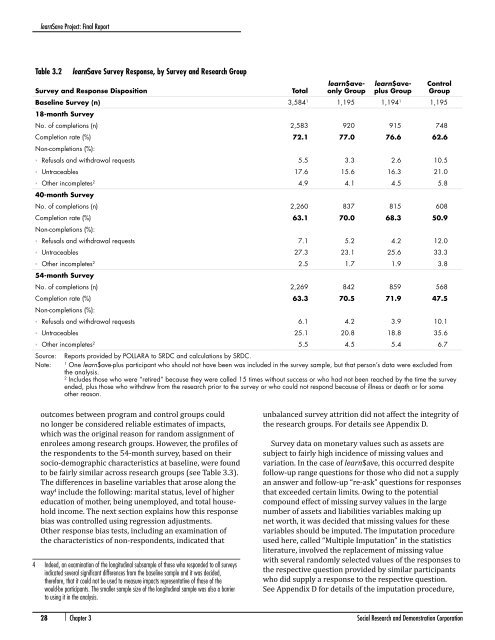Full report. - Social Research and Demonstration Corp
Full report. - Social Research and Demonstration Corp
Full report. - Social Research and Demonstration Corp
You also want an ePaper? Increase the reach of your titles
YUMPU automatically turns print PDFs into web optimized ePapers that Google loves.
learn$ave Project: Final ReportTable 3.2learn$ave Survey Response, by Survey <strong>and</strong> <strong>Research</strong> GroupSurvey <strong>and</strong> Response DispositionTotallearn$aveonlyGrouplearn$aveplusGroupBaseline Survey (n) 3,584 1 1,195 1,194 1 1,195ControlGroup18-month SurveyNo. of completions (n) 2,583 920 915 748Completion rate (%) 72.1 77.0 76.6 62.6Non-completions (%):▪▪Refusals <strong>and</strong> withdrawal requests 5.5 3.3 2.6 10.5▪▪Untraceables 17.6 15.6 16.3 21.0▪▪Other incompletes 2 4.9 4.1 4.5 5.840-month SurveyNo. of completions (n) 2,260 837 815 608Completion rate (%) 63.1 70.0 68.3 50.9Non-completions (%):▪▪Refusals <strong>and</strong> withdrawal requests 7.1 5.2 4.2 12.0▪▪Untraceables 27.3 23.1 25.6 33.3▪▪Other incompletes 2 2.5 1.7 1.9 3.854-month SurveyNo. of completions (n) 2,269 842 859 568Completion rate (%) 63.3 70.5 71.9 47.5Non-completions (%):▪▪Refusals <strong>and</strong> withdrawal requests 6.1 4.2 3.9 10.1▪▪Untraceables 25.1 20.8 18.8 35.6▪▪Other incompletes 2 5.5 4.5 5.4 6.7Source: Reports provided by POLLARA to SRDC <strong>and</strong> calculations by SRDC.Note:1One learn$ave-plus participant who should not have been was included in the survey sample, but that person’s data were excluded fromthe analysis.2Includes those who were “retired” because they were called 15 times without success or who had not been reached by the time the surveyended, plus those who withdrew from the research prior to the survey or who could not respond because of illness or death or for someother reason.outcomes between program <strong>and</strong> control groups couldno longer be considered reliable estimates of impacts,which was the original reason for r<strong>and</strong>om assignment ofenrolees among research groups. However, the profiles ofthe respondents to the 54-month survey, based on theirsocio-demographic characteristics at baseline, were foundto be fairly similar across research groups (see Table 3.3).The differences in baseline variables that arose along theway 4 include the following: marital status, level of highereducation of mother, being unemployed, <strong>and</strong> total householdincome. The next section explains how this responsebias was controlled using regression adjustments.Other response bias tests, including an examination ofthe characteristics of non-respondents, indicated that4 Indeed, an examination of the longitudinal subsample of those who responded to all surveysindicated several significant differences from the baseline sample <strong>and</strong> it was decided,therefore, that it could not be used to measure impacts representative of those of thewould-be participants. The smaller sample size of the longitudinal sample was also a barrierto using it in the analysis.unbalanced survey attrition did not affect the integrity ofthe research groups. For details see Appendix D.Survey data on monetary values such as assets aresubject to fairly high incidence of missing values <strong>and</strong>variation. In the case of learn$ave, this occurred despitefollow-up range questions for those who did not a supplyan answer <strong>and</strong> follow-up “re-ask” questions for responsesthat exceeded certain limits. Owing to the potentialcompound effect of missing survey values in the largenumber of assets <strong>and</strong> liabilities variables making upnet worth, it was decided that missing values for thesevariables should be imputed. The imputation procedureused here, called “Multiple Imputation” in the statisticsliterature, involved the replacement of missing valuewith several r<strong>and</strong>omly selected values of the responses tothe respective question provided by similar participantswho did supply a response to the respective question.See Appendix D for details of the imputation procedure,28 | Chapter 3 <strong>Social</strong> <strong>Research</strong> <strong>and</strong> <strong>Demonstration</strong> <strong>Corp</strong>oration




